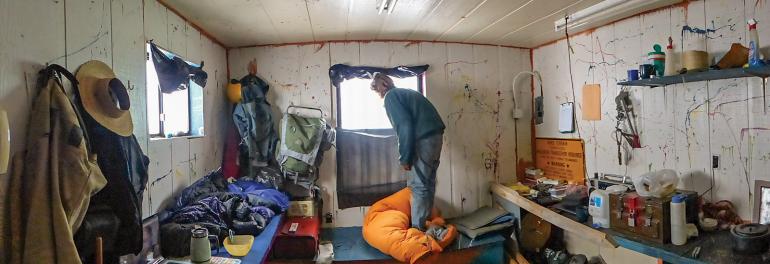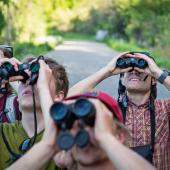Bird's-Eye View
Tales of soaring above the Bridgers.
On a sunny September afternoon in 2020, Bret Davis was watching birds from the Bridger ridge. As an observer with the Bridger Migration Project, his duty was to scan the sky to the north and count migrating raptors as they soared toward Mexico. Unbeknownst to him, the real action was taking place five miles to the south.
“I looked over my shoulder one minute, and everything was fine. Then I looked over my shoulder again and there was a massive plume of smoke,” Davis recalls.
Davis had witnessed the ignition of the Bridger Foothills Fire—a blaze that ultimately torched 8,000 acres and 30 homes just miles from downtown Bozeman—from a bird’s-eye perspective. He made a frenetic phone call to the fire department and raced off the ridge. “I bolted,” he says. “As soon as I saw the smoke, I grabbed my backpack and ran.”
The turnover to fall is predictably stunning. Golden aspens line Bridger Creek and coat the Bangtail Mountains to the east before the dramatic backdrop of the Crazy Mountains.
After a Bridger Bowl descent that would rival that of even the most courageous skier, Davis made it to the mouth of Bridger Canyon in the nick of time. “They were closing the road just as I got out,” he recalls.
When not serving as volunteer fire lookouts, observers with the Migration Project gather critical information about southwest Montana’s ecosystems. For 31 consecutive years, a cohort of field biologists and volunteers has roosted on the Bridger Bowl helipad to count migrating birds of prey. The project is part of a continent-wide effort to examine trends in raptor populations and behavior. “They’re environmental barometers,” says observer Luisa Frankenburg. “They can indicate a lot about ecosystems.
The migration season stretches from late August to the end of October. And run-ins with fire are more common than one might think—at least for Bret Davis.
Davis recalls another incident on the service roads of Bridger Bowl: “I was hauling too much weight in my truck up North Bowl road and had a radiator hose blow,” says Davis. “When I opened the hood and the air got in there, it flamed up.” To extricate the vehicle, a colleague utilized a wheel-loader tractor to lift the truck’s rear while Davis gripped the wheel with white knuckles and guided it down the switchbacks. “That was an exciting story,” Davis tells me with a grin. The fate of the truck? “I ended up selling it for $60.”
While the first month of the observation period is generally conducive to hawk watching, all bets are off for October.
The turnover to fall is predictably stunning. Golden aspens line Bridger Creek and coat the Bangtail Mountains to the east before the dramatic backdrop of the Crazy Mountains. September is often the last chance for critters to roam the ridgeline unencumbered by snow—which is sure to facilitate some unusual interactions. “I saw a golden eagle swoop at a mountain goat one time,” Davis remembers. “The goat kind of stamped at it on the second pass, and the eagle flew off.”
While the first month of the observation period is generally conducive to hawk watching, all bets are off for October. Davis recalls retreating to a Bridger Bowl ski-patrol hut to shelter from “some pretty heavy-duty storms” for days at a time. “We called it ‘the Penthouse,’” says Davis. In spite of the gilded title, the only luxurious feature of the shelter was the ridgetop view. In fact, the hut had to be torn down and rebuilt a handful of years ago after some unruly tenants took quarter. “Marmots had invaded the Penthouse,” Davis tells me with a laugh.
When observers emerge after a blizzard, it’s often to an alien landscape. “With hoarfrost on the trees and with the flat light, it’s a really eerie feeling,” says Davis. Another observer, Joshua Jaeger, recalls last year’s especially vicious storm in late October. “The Bridgers got 30 inches of snow in 36 hours,” he remembers. After some deliberation, Jaeger decided to stock up on supplies and try to stick it out from the ski-patrol hut until the end of the month. “I didn’t want to throw in the towel,” Jaeger says.
He then spent eight days on the Ridge, counting raptors while the weather was clear. “I was isolated,” he says. “I might as well have been on an island in the middle of the ocean.” After a long and lonely week, Jaeger made his descent from the Ridge on the final day of the month. “I don’t regret doing what I did,” Jaeger tells me. “I consider it a unique experience.”
Over the course of a season, an observer with the Bridger Migration Project spends more than 300 hours perched atop the Bridger Ridge, eyes to the sky. To endure, the passion has to burn hot. “I never get sick of watching birds,” Jaeger professes. “That’s everyone’s dream—to do what they love for a living.”
Every observer I’ve spoken with has enthusiastically encouraged public participation. Visitors aren’t guaranteed to spot a raging forest fire, or even their favorite migratory raptor, but with a view of four mountain ranges, three rivers, and the glamour of the Gallatin Valley in fall plumage, they’ll quickly discover that a pair of binoculars at 8,600 feet can offer something exceptional: a bird’s-eye view.















































